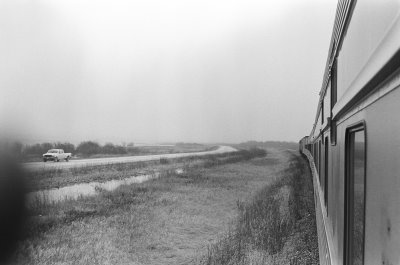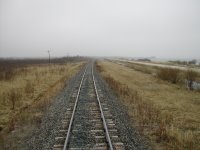 After we leave the Pas, I return to the sleeper car to read and to gaze out of the window. It’s hard to identify any clear change in the landscape that we are passing through. It is already less agricultural than the south of the province, but the forests come and go, and we frequently pass alongside lakes or streams: you don’t have long to wait until you see a body of water somewhere.
After we leave the Pas, I return to the sleeper car to read and to gaze out of the window. It’s hard to identify any clear change in the landscape that we are passing through. It is already less agricultural than the south of the province, but the forests come and go, and we frequently pass alongside lakes or streams: you don’t have long to wait until you see a body of water somewhere. At about 11.30 the service manager passes by. She offers very briefly to let me look out of the train from the vestibule at the end of our car. As we slow to a gentle crawl alongside the vast expanse of Cormorant Lake, I am able to lean out and take a photograph looking along the length of our train as it turns on a corner. Take note, however. She explains to me how frustrating it can be to deal with eager rail fans and tourists who let themselves out onto this open deck to take photographs. It’s not strictly permitted, and can get you and the crew into some trouble. So if you ever want to take a photo from back here, be sure to be on good terms with the crew first, and ask politely for them to acompany you back there when it’s safe and convenient for them. And don’t forget that a little gratuity at the end of a trip will always be appreciated by the on board crew.
At about 11.30 the service manager passes by. She offers very briefly to let me look out of the train from the vestibule at the end of our car. As we slow to a gentle crawl alongside the vast expanse of Cormorant Lake, I am able to lean out and take a photograph looking along the length of our train as it turns on a corner. Take note, however. She explains to me how frustrating it can be to deal with eager rail fans and tourists who let themselves out onto this open deck to take photographs. It’s not strictly permitted, and can get you and the crew into some trouble. So if you ever want to take a photo from back here, be sure to be on good terms with the crew first, and ask politely for them to acompany you back there when it’s safe and convenient for them. And don’t forget that a little gratuity at the end of a trip will always be appreciated by the on board crew. The service manager explains to me the crewing of the train. In addition to the three VIA staff on board the passenger cars, there are always two engineers up front. Both operate together, and change for a fresh crew at certain points along the way. Going north, the crew changes in Dauphin, Canora, The Pas, Thompson and Gillam. North of Thompson, the Hudson Bay Railway requires that the ticket collecting and train management be handled by two of their employees, so there are another four employees who work in pairs from Thompson to Gillam and Gillam to Churchill. By my calculations, and assuming that the same engineers who operate the train between two points going northbound get back on board to operate it on it’s return between those points, the ‘Hudson Bay’ employs 21 VIA Rail and Hudson Bay Railway employees. Impressive, when you consider that for much of our trip, the passenger count was in single figures.
The service manager explains to me the crewing of the train. In addition to the three VIA staff on board the passenger cars, there are always two engineers up front. Both operate together, and change for a fresh crew at certain points along the way. Going north, the crew changes in Dauphin, Canora, The Pas, Thompson and Gillam. North of Thompson, the Hudson Bay Railway requires that the ticket collecting and train management be handled by two of their employees, so there are another four employees who work in pairs from Thompson to Gillam and Gillam to Churchill. By my calculations, and assuming that the same engineers who operate the train between two points going northbound get back on board to operate it on it’s return between those points, the ‘Hudson Bay’ employs 21 VIA Rail and Hudson Bay Railway employees. Impressive, when you consider that for much of our trip, the passenger count was in single figures. Signs of human life recede, and although I know that we are running nearly parallel to route 39 (running from north of The Pas to Thompson) it’s not often that it runs right alongside the track. We make a few stops along this stretch: Cormorant announces itself as we rattle over a level crossing and I look up to see a ubiquitous North American yellow school bus. We reach Wekusko at 13.55. At these stops maybe one or two coach passengers get on or off. At this time of year the true nature of the train is revealed. This heavily government-subsidised train offers a life line to the remote communities of northern Manitoba. Most are Indian communities, some in designated reserves. At some stops no passengers board or disembark, but food or other supplies that have been ordered by telephone are unloaded from the freight car at the front of the train.
Signs of human life recede, and although I know that we are running nearly parallel to route 39 (running from north of The Pas to Thompson) it’s not often that it runs right alongside the track. We make a few stops along this stretch: Cormorant announces itself as we rattle over a level crossing and I look up to see a ubiquitous North American yellow school bus. We reach Wekusko at 13.55. At these stops maybe one or two coach passengers get on or off. At this time of year the true nature of the train is revealed. This heavily government-subsidised train offers a life line to the remote communities of northern Manitoba. Most are Indian communities, some in designated reserves. At some stops no passengers board or disembark, but food or other supplies that have been ordered by telephone are unloaded from the freight car at the front of the train.Gradually I detect a change in the vegetation up here. The luscious arboreal forests have been replaced by bands of thin, leafless trees. Some areas were burnt out by forest fires, and you can begin to guess how long as elapsed since the burning by the size of the young saplings that are growing up from the forest floor.
I’m reading for much of this trip. I’m deep in the awful spy thriller paperback that I picked up in Denver (Johnny Fedora on assignment in Trieste). I escape his compulsively addictive adventures to catch sight of Hargrave Lake, which appears briefly to my right, a small blot on my map, but an immense volume of water that stretches to the horizon.
No comments:
Post a Comment